Diving with Butterflyfishes and Coralfishes
Lanta Marine Life | Chaetodontidae
Butterflyfish, with their wonderful display of colours and patterns, are a common sight around the reefs and corals while diving from Koh Lanta.
Sometimes confused with angelfishes, the family Chaetodontidae has over 100 species of butterflyfish, including coralfish and bannerfish.
Often brightly coloured yellow, red or white, with black, orange, or red markings, butterflyfish have thin, colourful, disk-shaped bodies, a small mouth, protruding snout, and can range in size from 8 cm up to 20 cm for larger species such as the lined butterflyfish.
Many have an eye-like spot on their rear and dark bands across their eyes used to confuse their predators into which way they might flee. These defensive patterns are often likened to those of butterflies, hence the name.
The dorsal fin is an uninterrupted row of tough spines, with a tail fin that may be rounded or concave but never forked.
During the night, Butterflyfish hide in cracks and crevices exhibiting markedly different colours, camouflaging themselves into their surroundings.
Butterflyfish tend to stick to a particular home territory, constantly grazing on coral and rock formations in search of algae, coral polyps, worms, and other small invertebrates.
Their continual munching keeps the coals free of algae and sediment, allowing them to breathe and maintain healthy growth.
These important reef-dwellers are usually found in the shallower parts of the dive sites, with few venturing below 18 - 20 metres.
We can often see small schools of white collar butterflyfish at all of the dive sites around Koh Lanta, with many other species usually seen in pairs. It’s unusual to see a solitary butterflyfish on the dive sites around Koh Lanta.
Butterflyfish are pelagic spawners, releasing hundreds of eggs into the water. The buoyant eggs float up to become part of the plankton layer, drifting with the currents until hatching.
Butterflyfish are found in all tropical waters around the world, though concentrated in the Indo-Pacific region.
24 species found on this page:
- Longfin Bannerfish (Heniochus acuminatus)
- Singular Bannerfish (Heniochus singularis)
- Phantom Bannerfish (Heniochus pleurotaenia)
- Black Pyramid Butterflyfish (Hemitaurichthys zoster)
- Copperband butterflyfish (Chelmon rostratus)
- White Collar Butterflyfish (Chaetodon collare)
- Lined Butterflyfish (Chaetodon lineolatus)
- Raccoon Butterflyfish (Chaetodon lunula)
- Rainbow Butterflyfish (Chaetodon trifasciatus)
- Indian Vagabond Butterflyfish (Chaetodon decussatus)
- Threadfin Butterflyfish (Chaetodon auriga)
- Vagabond Butterflyfish (Chaetodon vagabundus)
- Eight-banded Butterflyfish (Chaetodon octofasciatus)
- Latticed Butterflyfish (Chaetodon rafflesii)
- Triangular Butterflyfish (Chaetodon triangulum)
- Andaman Butterflyfish (Chaetodon Andamanensis)
- Chevron Butterflyfish (Chaetodon trifascialis)
- Black-backed Butterflyfish (Chaetodon melannotus)
- Meyer's Butterflyfish (Chaetodon Meyersi)
- Yellowback Butterflyfish (Chaetodon mertensii)
- Sunburst Butterflyfish (Chaetodon kleinii)
- Longnose Butterflyfish (Forcipiger flavissimus)
- Highfin Butterflyfish (Coradion altivelis)
- Orange-banded Coralfish (Coradion chrysozonus)
Longfin Bannerfish
(Heniochus acuminatus)

Heniochus acuminatus @ Koh Haa
The longfin bannerfish is often confused with the Moorish idol, however there are a few distinct differences.
The longfin bannerfish grows to 25 cm and has a white body with a pair of diagonal black bands. The dorsal, pectoral and tail fins are yellow. The first dorsal ray fin is white and elongate, creating a trailing filament. The snout has black spots and slightly stretched to the small mouth.
The longfin bannerfish is usually seen at the dive sites around Koh Lanta in small groups of 2 - 5 individuals and its diet includes zooplankton in the water column and bottom-dwelling invertebrates.
Singular Bannerfish
(Heniochus singularis)

Heniochus singularis @ Hin Bida
The singular bannerfish is the largest of the bannerfish, growing to 23 cm. The body and anal fin are coloured black, with the dorsal fin and tail fin being yellow.
The first dorsal fin ray is long and white. There is a small white stripe in front of the eye, and a large white bar behind the eye. This species has a noticeable bump on the nape (above the forehead).
The singular bannerfish feeds on coral polyps and prefers areas of rich coral growth. These fish are observed both solitary, and in small groups. A slightly less common species.
Phantom Bannerfish
(Heniochus pleurotaenia)

Heniochus pleurotaenia @ Hin Bida
The phantom bannerfish has a white body background with two wide dark bands on the side, becoming brownish/yellowish as they converge toward the dorsal area.
The first rays of the dorsal fin are stretched in a short white feather-like filament. This species has a pair of horns just above the eyes, and further above, a prominent bony bump on the nape (above the forehead).
The phantom bannerfish is less commonly seen around the reef areas and grows to 17 cm. It can be observed, solitary, in pairs or small groups and can be found in a mixed algae and coral habitat.
Black Pyramid Butterflyfish
(Hemitaurichthys zoster)

Hemitaurichthys zoster @ Koh Haa
The black pyramid butterflyfish, or 'zoster butterflyfish' reaches 16 cm. The body is black, with a wide white trapezoid band through the middle of the body.
The dorsal fin is black, with a yellow mid-section above the white body bar. The tail fin is white.
This species is usually found in pairs or small groups feeding on the edge of the reef, or above the reef. The diet includes algae and zooplankton.
Copperband butterflyfish
(Chelmon rostratus)
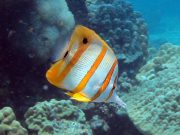
Chelmon rostratus @ Koh Haa
The copperband butterflyfish is sometimes called the beaked coralfish and is common at all of our dive sites.
This fish has a long beak-like snout and a silvery-white body with three orange body bars, and one orange bar through the eye.
The rear dorsal fin has a dark eye-like spot designed to confuse would-be predators. There is a black bar on the base of the tail.
The copperband butterflyfish grows to 20 cm and is seen both solitary, and in pairs. It uses its long snout to pick out bottom dwelling creatures from cracks and crevices, including worms and small crustaceans.
White Collar Butterflyfish
(Chaetodon collare)
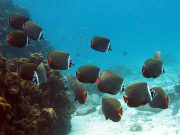
Chaetodon collare @ Koh Haa
The white collar butterflyfish, or redtail butterflyfish grows to 18 cm. The body is generally dark grey, with lighter scale centers giving it a spotted appearance.
The tail base is bright red, followed by a black stripe and a whitish margin. There is a prominent, vertical white bar behind the eyes, a dark bar over the eyes, and another, smaller white bar in front of the eyes.
The white collar butterflyfish is often seen in pairs or aggregations and its diet includes soft and hard coral polyps.
Lined Butterflyfish
(Chaetodon lineolatus)

Chaetodon lineolatus @ Koh Haa
The Lined Butterflyfish is the largest of all Butterflyfish, growing to 30 cm in length.
The body is white with vertical black lines and a broad yellow and black band at the rear of the body. There is a wide black eye-stripe which contains a white spot on the forehead. The dorsal, anal and tail fins are all yellow.
Whilst this species is generally uncommon, it is in fact quite common at the dive sites around Koh Lanta and is seen both solitary, and in pairs.
The Lined Butterflyfish diet includes both soft and hard coral polyps, anemones, algae and other invertebrates.
Raccoon Butterflyfish
(Chaetodon lunula)

Chaetodon lunula @ Koh Haa
The Raccoon Butterflyfish has a yellow-orange body with a dusky back and 6 - 7 thin reddish/dark diagonal stripes.
The dark eye-band is followed by a strong white patch, which is connected to a wide dark band which runs to the dorsal fin. There is a black spot on the tail fin base.
The Raccoon Butterflyfish grows to 21 cm and is observed both solitary and in pairs. This species's diet includes nudibranchs, tubeworms, algae and coral polyps.
Rainbow Butterflyfish
(Chaetodon trifasciatus)

Chaetodon trifasciatus @ Koh Haa
The Rainbow Butterflyfish, or Melon Butterflyfish, grows to 15 cm. This species has a pale yellowish body which become bluish toward the rear. The body is covered with many oblique purplish stripes.
Both the anal fin and the base of the tail fin are orangeish/reddish, and the base of the anal fin has a yellow-edged black band. There may also be some reddish colouring on the head and snout.
The Rainbow Butterflyfish is territorial and aggressive to other butterflyfishes. They often swim in pairs and their diet consists of coral polyps.
Indian Vagabond Butterflyfish
(Chaetodon decussatus)

Chaetodon decussatus @ Koh Haa
The Indian vagabond butterflyfish has a pearly white body with a chevron pattern of two sets of opposing diagonal dark lines and looks very similar to the vagabond butterflyfish.
There are several fine orange stripes across the forehead, and the tail is yellow. This species can grow to 20 cm in length and can be observed solitary, or in pairs and its home range is rubble or coral rich areas.
This species has a dark stripe through the eye, and another through the tail fin.
Unlike the similar looking vagabond and threadfin butterflyfishes, the Indian vagabond butterflyfish has a wide black band across the rear of the body which covers the rear dorsal fin.
Threadfin Butterflyfish
(Chaetodon auriga)

Chaetodon auriga @ Koh Haa
The threadfin butterflyfish is very similar to the vagabond and indian vagabond butterflyfishes and grows to 23 cm.
The body has a chevron pattern of two sets of opposing diagonal dark lines. There is a prominent vertical black band through the eye and several fine orange stripes across the forehead.
The rear body and tail are yellow, with a dark spot on the rear of the dorsal fin. The dorsal fin usually trails a thread-like filament.
The threadfin butterflyfish is usually observed solitary, or in pairs, but may also roam over large distances in search of food in small aggregations.
The diet of this species includes algae, bristle-worms, anemones and coral polyps.
Vagabond Butterflyfish
(Chaetodon vagabundus)
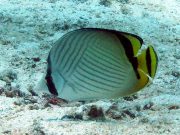
Chaetodon vagabundus @ Koh Haa
The vagabond butterflyfish has a pearly white body with a chevron pattern of two sets of opposing diagonal dark lines.
There are several fine orange stripes across the forehead, and the tail is yellow. This species can grow to 23 cm in length and can be observed solitary, or in pairs.
This species has three dark stripes, one through the eye, one across the rear of the body, and one through the tail fin.
The vagabond butterflyfish can be distinguished from other similar looking species (Indian vagabond and threadfin butterflyfishes) by the narrow black band across rear body which does not cover the entire rear dorsal fin.
Eight-banded Butterflyfish
(Chaetodon octofasciatus)

Chaetodon octofasciatus @ Koh Bida
The eight-banded butterflyfish is a small species, growing to 12 cm. The body colour varies from white to a strong yellow colour.
Individuals with a lighter body colour may also have a dark spot on the base of the tail.
There are 7 black bars over the head and sides, one black bar in the middle of the snout, and another black bar which forms a strong margin on the end of the dorsal and anal fins. The tail also has a vertical black bar.
This species feeds on coral polyps and juveniles are usually found sheltering within the branches of staghorn corals. Adults are often seen in pairs.
Latticed Butterflyfish
(Chaetodon rafflesii)

Chaetodon rafflesii @ Hin Bida
This species has a yellow body with a darker cross-hatched pattern on the sides.
There is a black vertical bar across the eye, and a black vertical band through the tail fin.
The dorsal fin also has a black stripe, widest where it meets the tail fin. The forehead may be bluish/white.
The latticed butterflyfish is an uncommon species which grows to 18 cm, but is usually observed smaller, around 15 cm.
This species is often seen in pairs and lives in shallow coral rich areas, usually to 15 m. The diet includes anemones, bristle-worms, and soft and hard coral polyps.
Triangular Butterflyfish
(Chaetodon triangulum)

Chaetodon triangulum @ Koh Haa
The triangular butterflyfish has a roughly triangular shaped body and is generally grey with many pale yellow chevron markings and a dark triangle on the tail. This fish grows to 15 cm.
The triangular butterflyfish can often be found within the branches of staghorn corals (acropora corals) where it feeds on coral polyps. This is territorial species which normally only forms pairs for breeding.
Andaman Butterflyfish
(Chaetodon Andamanensis)
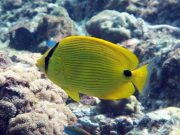
Chaetodon Andamanensis @ Koh Bida
The Andaman butterflyfish grows to 15 cm and has a bright yellow body with numerous faint stripes.
There is a blue-edged black band through the head and eyes and a black spot on the base of the tail. The mostly yellow tail has an almost clear rear margin.
The Andaman butterflyfish is sometimes observed solitary, but mostly in pairs and its diet consists of coral polyps.
Chevron Butterflyfish
(Chaetodon trifascialis)

Chaetodon trifascialis @ Koh Haa
The chevron butterflyfish has an elongate (stretched) white body with numerous black chevron markings, a black chevron band through the eye, a black tail with a yellow margin and may grow to 18 cm.
This species is territorial and will defend coral patches against other butterflyfish. The chevron butterflyfish can often be found in shallow areas around table and other staghorn corals, feeding on the coral polyps.
Juvenile chevron butterflyfishes have a broad black band extending from the rear of the dorsal fin to the rear of the anal fin a mostly yellow tail.
Black-backed Butterflyfish
(Chaetodon melannotus)

Chaetodon melannotus @ Koh Bida
The black-backed butterflyfish grows to 18 cm and can often be found around staghorn corals.
This species has a white body with many ascending black lines, a black band through eye, is black on the upper back and has a black tail base.
This species can be observed solitary, or in pairs and its diet included the polyps of both hard and soft corals.
Meyer's Butterflyfish
(Chaetodon Meyersi)

Chaetodon Meyersi @ Hin Muang
The Meyer's Butterflyfish has a light greyish body colour with thick black lines running through the face, and diagonally across the body.
The mouth and eye bars have yellow margins and the fins are yellow with black sub-margins.
A thick dark curved line runs from the anal fin to the gills and up along the dorsal fin to the rear of the body.
The rear dorsal fin has a vertical band of small dark orange dots and there are two thin dark orange vertical bands on the tail fin.
The Meyer's Butterflyfish can grow to 20 cm and is shy and not usually observed at the dive sites around Koh Lanta.
The diet is exclusively coral polyps.
Yellowback Butterflyfish
(Chaetodon mertensii)

Chaetodon mertensii @ Hin Daeng
The Yellowback Butterflyfish has a white body with a yellow tail margin and a thick yellow to orange band from the rear dorsal fin, narrowing to the tip of the anal fin.
There is a small dark forehead spot with a white margin and similar dark vertical eye stripe with a white margin.
The main body has 7 - 8 chevron markings, with a short gap before the rear yellow band.
The Yellowback Butterflyfish grows to 12 cm, but usually observed less than 10 cm and not very common around Koh Lanta.
Sunburst Butterflyfish
(Chaetodon kleinii)
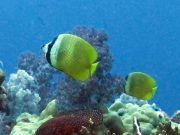
Chaetodon kleinii @ Hin Muang
The Sunburst Butterflyfish has a generally yellow to yellowish-brown body with a whitish head and a diffuse vertical band on the forebody.
There is a dark vertical eye bar and the tip of the snout may also be black.
The Sunburst Butterflyfish has a yellow tail with a transparent tail fin margin. The scales may have lighter, or darker spots on them, giving the impression of rows or bands of spots running horizontally along the body.
The rear dorsal and anal fin may have a light margin.
The Sunburst Butterflyfish grows to 15 cm and can be observed singly or in pairs. Whilst a generally common butterflyfish, this species is rarely seen at the dive sites around Koh Lanta.
The diet includes soft coral polyps, algae and zooplankton.
Longnose Butterflyfish
(Forcipiger flavissimus)

Forcipiger flavissimus @ Koh Haa
The longnose butterflyfish has a yellow body and a distinct long snout with small mouth. The head is black on top, and silvery-white on the lower part. There is a dark spot on the anal fin, just below the base of the tail fin.
This species grows to 22 cm and is seen solitary and in small groups up to 5 individuals. Adults are usually seen in pairs and are territorial.
The diet consists of hydroids, fish eggs, small crustaceans, bristle-worm tentacles, and the tube feet of sea stars and sea cucumbers.
Can be confused with the 'big longnose butterflyfish' (Forcipiger longirostris) which has a longer snout and black spots on the white breast.
Highfin Butterflyfish
(Coradion altivelis)

Coradion altivelis @ Hin Klai
The Highfin Butterflyfish has a white body undercolour, with four brown to dark yellow bands, the first through the eye, the second from the front of the dorsal fin to the ventral fin, shortly followed by the third, and the final broad band at the rear of the body.
There is a dark band at the base of the tail fin and a dark spot at the front of the dorsal fin.
Very similar to the Orange-banded Coralfish (Coradion chrysozonus) but lacks the ocellated spot on the rear dorsal fin.
The Highfin Butterflyfish is a rare and poorly studied species, growing to 18 cm, but usually observed around 10 cm - 12 cm. Forms pairs during breeding.
Orange-banded Coralfish
(Coradion chrysozonus)
The Orange-banded Coralfish is white, with a wide orange bar across the rear body, including the dorsal and anal fins. There are a pair of closely spaced orange to brown bars behind the head.
Similar to the Highfin Coralfish (Coradion altivelis. above), there is a dark band on the tail base and a dark spot on the forward dorsal fin, however this species has an ocellated spot on the rear dorsal fin.

Coradion chrysozonus @ Hin Klai
The Orange-banded Coralfish and the Highfin Coralfish are members of the same genus, Coradion, and can sometimes be seen swimming together.
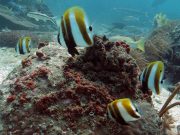
2 Pairs of Coradion chrysozonus & Coradion altivelis together @ Hin Klai
The Orange-banded Coralfish grows to 15 cm and feeds on sponges.
Diving with Butterflyfishes and Coralfishes around Koh Lanta
Scuba Diving & Snorkel Trips
If you'd love a chance to spot Butterflyfishes and Coralfishes on one of our daily high season diving trips from Koh Lanta then send us an email to info@diveandrelax.com.
Join our high season speedboat dive trips to some of Thailand's best dive sites and enjoy small groups, short journey times, with a focus on great personal service, safety and fun.
Not yet a certified diver? Learn to Scuba Dive on Koh Lanta with the 3 day SSI Open Water Diver course.
Book online to save 10% on dive trips and scuba courses on Koh Lanta.
Find Out More
Indo-Pacific Marine Life Guides
- Allen, G., Steene, R., Humann, P., DeLoach, N. (2003) Reef Fish Identification, Tropical Pacific. Jacksonville, FL., USA: New World Publications, Inc., ISBN 1-878348-36-1.
- Humann, P., DeLoach, N., (2010) Reef Creature Identification, Tropical Pacific. Jacksonville, FL., USA: New World Publications Inc., ISBN 978-1-878348-44-9
- Debelius, H. (2013) Indian Ocean Reef Guide. Frankfurt, Germany: IKAN - Unterwasserarchiv, ISBN 978-3-939767-52-7.
- Debelius, H. (2004) Nudibranchs and Sea Snails, Indo-Pacific Field Guide. Frankfurt, Germany: IKAN - Unterwasserarchiv, ISBN 3-925919-51-1
- Erhardt, H., Knop, D. (2015) Corals Indo-Pacific Field Guide. Frankfurt, Germany: IKAN - Unterwasserarchiv, ISBN 3-925919-69-4.
- Veron J.E.N., Stafford-Smith M.G., Turak E. and DeVantier L.M. (2016). Corals of the World
